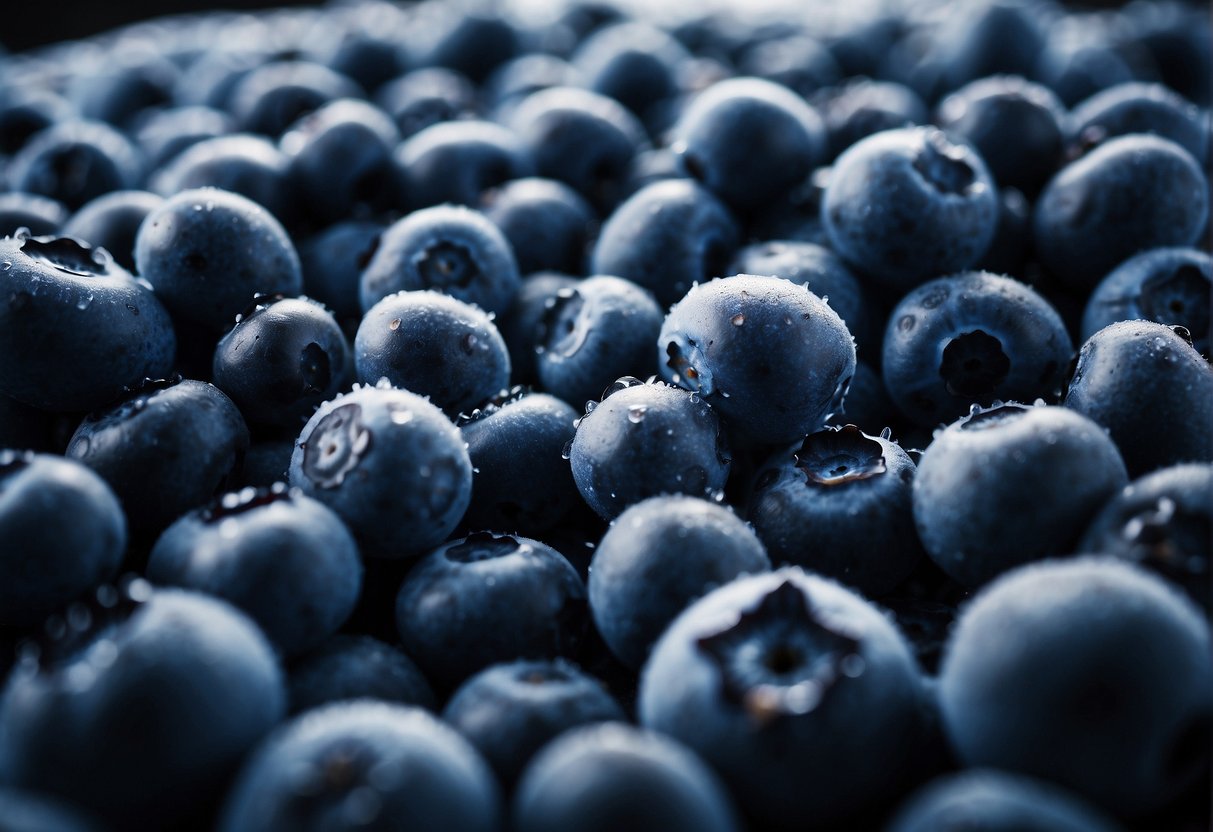Understanding E. Coli and Its Relationship with Frozen Blueberries
When I chat about E. Coli, I’m referring to a type of bacteria that can sometimes sneak into our food supply. It’s most famous for showing up in raw or undercooked meat, but these little buggers can also make a surprise appearance in produce, like my favorite snack, frozen blueberries.
You might think freezing temperatures would show these pathogens the door. Unfortunately, that’s not the case. While freezing can put a pause on bacteria’s activities, it doesn’t always give them the boot. So, they’re just kicking back in a chilly slumber, ready to wake up in warmer surroundings.
Here’s the scoop on why:
- Temperature: Freezing puts E. Coli into a dormant state but doesn’t kill it.
- Food Safety: Always important, from the farm to my freezer. If the berries mix with contaminated water or surfaces, there’s a chance for trouble.
- Contamination: Can happen before the berries ever hit the freezer, often through water or soil that’s had a bit of a run-in with E. coli.
What’s super important to keep in mind is that foodborne illnesses don’t just vanish in the cold. The fact that E. Coli can hang out in frozen blueberries definitely had me raising an eyebrow. And if there’s ever a whisper of an outbreak, a recall can happen to pull affected products off the shelves.
So, I always make sure my blueberry delights are coming from a reliable source. And that’s the cold, hard truth about these popsicle-textured gems and their relationship with E. Coli.
The Freezing Process and Bacterial Survival

When I stash my blueberries in the freezer, I’m aiming to keep them fresh, but what about those pesky bacteria? Let’s hone in on what freezing does, specifically to E. coli, and how it affects the survival of bacteria in general.
Does Freezing Kill E. Coli?
My expectation rolling blueberries into the freezer is that the cold’s gonna zap all the bad stuff, right? Not exactly—the thing with E. coli is, these tough little critters have the chops to survive the chill. Freezing my favorite berries to 0 °F will press the pause button on bacteria like E. coli, but it won’t send them to their demise. Once I bring the berries back up to room temp, those bacteria are ready to party like nothing happened. This info isn’t just me talking; it comes straight from the horse’s mouth at USDA.
Impact of Freezing on Bacterial Viability
Taking a closer peek, the impact of freezing on bacterial viability gets real interesting. The process itself doesn’t wipe out bacteria—their activities just get suspended. So, when my blueberries are frozen, any bacteria like E. coli hanging out on them are essentially put into a deep freeze. They aren’t causing trouble while in that state, but they’re still around. It’s like they’re all just chillin’ (pun intended) and waiting for the thaw to get back into action. The science backs this up, with findings that show pathogens can endure frozen states, detailed in an NPR article.
Risk Factors for E. Coli in Frozen Blueberries
I’m about to uncover the journey of blueberries from bush to bag, and trust me, it’s way more complex than one might think. When it comes to frozen blueberries, E. coli is something we definitely don’t want tagging along.
Farm to Freezer: Points of Contamination
At the farm level, there’s a lot that has to go right to keep E. coli away from my favorite frozen treats. Water is a major player here – it’s used for irrigation and if it’s contaminated, it can transfer E. coli to fresh produce. Another risk factor is animals roaming near the bushes. They might be cute, but they’re also carriers of E. coli, which can easily spread to the berries.
Frozen fruit, like my blueberries, might seem safer due to the chill factor, but don’t be fooled; freezing doesn’t kill E. coli, so contaminated fruit will stay that way even when frozen. And let’s not forget that the equipment used for picking and processing can also be a culprit if it’s not properly sanitized.
How Contamination Occurs in Berries
Now, how can these little berries get ensnared by E. coli, you wonder? Even when they’re destined to be frozen, the risks start right from the farm. From the get-go, if the berries are harvested with dirty equipment or by workers with unclean hands, we’re off to a bad start.
Next up, packaging matters more than you’d think. If those packs or the facility where my blueberries are bagged are contaminated, that’s basically an invitation for E. coli to come to the party. Considering how delicate the balance of food safety is, it’s clear to see that keeping E. coli out of frozen blueberries takes diligence every step of the way.
Safety Measures and Handling of Frozen Blueberries

When it comes to blueberries, my motto is safety first. Ensuring these tasty berries are free from harmful bacteria like E. coli is a top priority, especially when it comes to handling their frozen versions.
Best Practices for Food Safety
First things first, let’s talk about food safety. I always make sure my blueberries are sourced from reputable suppliers who adhere to strict food safety guidelines. Washing the berries prior to freezing is a must. Even after freezing, I keep an eye on the temperature of my freezer; it should consistently be at 0°F or lower to prevent potential foodborne illness. Cross-contamination is a no-go, so I store my blueberries away from any raw meat or seafood.
Proper Thawing and Cooking Techniques
When thawing frozen blueberries, patience is key. I ensure they’re thawed in the refrigerator or by using a microwave on the defrost setting. This keeps the berries out of the “danger zone” temperature range where bacteria thrive. I prefer the fridge method—it’s slow but incredibly safe. If I’m baking or cooking with blueberries, I mix them in while they’re still frozen. The high heat during cooking does a great job at killing any lingering bacteria. For recipes needing thawed berries, gentle heating in a saucepan works too, just enough to get them to the right consistency.
Identifying and Reacting to E. Coli Outbreaks

When I hear about E. Coli outbreaks, the priority is to understand the symptoms and know how to react if there’s a suspicion of contamination. Time is of the essence because E. Coli can cause serious illness.
Recognizing Symptoms of E. Coli Infection
The first thing I look out for is diarrhea, which can be bloody, and it’s often the most common symptom. Then there’s the fever, which might not be as high as with other infections. The CDC states symptoms usually show up three to four days after exposure, but they can start as early as one day or as late as ten days.
Steps to Take if Contamination is Suspected
If I think I’ve eaten something contaminated, I’d follow these steps:
- Reach out to my healthcare provider, especially if the diarrhea is persistent or bloody.
- Check with the FDA and CDC for alerts and recalls related to E. Coli, which helps me identify the source.
- In case of severe symptoms—like if I’m getting dehydrated or if I feel unusually weak—I’d seek medical attention immediately. Some cases may require hospitalization.
With diligence and swift action, I can manage my risk during an E. Coli outbreak and take the necessary steps to stay safe.
Preventing E. Coli in Frozen Fruit Production

In my work around frozen fruit production, I’ve found that staying ahead of E. Coli involves stringent industry regulations and embracing the latest technological innovations in food safety.
Industry Regulations and Standards
To keep frozen fruits like blueberries safe from E. coli, I pay close attention to guidelines from reputable bodies such as the American Frozen Food Institute (AFFI) and the FDA. My production facility strictly adheres to Good Manufacturing Practices (GMPs), which cover everything from the cleanliness of equipment to employee hygiene. Plus, I always monitor for potential foodborne illnesses through rigorous testing protocols aimed at detecting contaminants early on. It’s my job to ensure that each batch meets the standards for safety before it’s even packaged.
Technological Innovations in Food Safety
Here at my facility, I use cutting-edge technology to bolster our food safety measures. For example, I’ve implemented advanced freezing techniques that reduce the likelihood of bacterial growth. I also make sure to invest in equipment that comes with built-in sanitation processes, effectively minimizing contamination risks. Packaging too plays a vital role – I’ve seen how smart packaging can alert us to temperature changes that could compromise the fruit’s safety. I’m always keeping an eye out for recalls or food safety alerts, so I can respond rapidly to protect the consumers and uphold our brand’s reputation.
Myths and Facts About Frozen Blueberries and E. Coli

When it comes to frozen blueberries, there’s a bit of confusion around whether they can harbor E. coli. I’ll break it down so you know exactly what’s myth and what’s fact.
Debunking Common Misconceptions
Myth: Frozen blueberries are always safe to eat straight from the bag because freezing kills E. coli.
Fact: While freezing can significantly reduce the number of pathogens, it does not always kill all harmful bacteria such as E. coli. Although it’s rare, there have been instances where frozen fruits including blueberries were linked to E. coli outbreaks.
Myth: Thawing frozen blueberries eliminates the risk of E. coli contamination.
Fact: Simply thawing your blueberries won’t get rid of potential E. coli bacteria. The safest method is to cook them, ensuring the temperature reaches at least 85°C for a minimum of one minute to effectively kill most bacteria.
Understanding the Truth Behind Freezing and Bacteria
Fact: Freezing is a method used to preserve the taste and nutritive value of blueberries and does not guarantee that they are pathogen-free. Even though the risk of contracting an E. coli infection from frozen blueberries is low, it’s important to practice proper food safety protocols like cooking them before consumption, especially in dishes where they won’t be cooked like smoothies or salads.
Nutritional Considerations and Benefits of Frozen Blueberries

When I stock up my freezer with frozen blueberries, I’m not just thinking about the convenience. I know I’m also getting a powerhouse of nutrients. These little berries are more than just a tasty snack; they’re chock-full of vitamins and minerals. For instance, I get a good dose of vitamin C, manganese, and fiber from them. What’s even cooler is that the nutrient levels don’t drop in the freezing process. The fiber and protein content stay pretty steady at around 4 grams of fiber and 1 gram of protein per cup.
- Vitamins & Minerals: A cup of frozen blueberries provides manganese, potassium, iron, magnesium, phosphorus, zinc, and calcium.
- Antioxidants: Blueberries are famous for their antioxidants, particularly anthocyanins, which are said to have a range of health benefits. And guess what? Freezing actually increases the antioxidant value.
A quick peek into the nutrient breakdown of these berries reveals some impressive numbers. According to this in-depth nutrition comparison, frozen wild blueberries have more manganese and fiber compared to their fresh counterparts.
I’m always amazed at how these nutrients contribute to my overall health. They support my immune system, help maintain healthy bones, and even play a role in managing blood sugar levels. While I munch on these delightful berries straight from my freezer, I feel good knowing that they are not just satisfying my sweet tooth but also giving a boost to my day with their nutritional benefits.
Frequently Asked Questions

Let me run you through some quick bits about frozen blueberries and safety that you might be noodling on.
Is it safe to snack on frozen berries straight out of the bag?
I’ve seen reports suggesting that it’s not always safe to eat frozen fruits straight from the bag due to the risk of contamination. It’s better to be safe than sorry, so give them a rinse first.
Are there any recent health recalls on frozen blueberries I should be aware of?
I would suggest keeping an eye on official food safety announcements. Back in 2016, there were recalls on frozen produce due to health concerns.
Could eating frozen fruits mess with my digestion?
In general, eating frozen fruits shouldn’t cause digestive issues. However, if you’ve got a sensitive stomach, the coldness might catch you off guard. Just let them thaw a bit before digging in.
Is having a daily serving of frozen berries totally cool for my health?
Yep, having a daily serving of frozen berries is a thumbs up for health. They’re packed with vitamins and good for your daily fruit intake.
Does chucking fruit in the freezer zap all the gnarly bugs and parasites?
Freezing fruit doesn’t kill bacteria. In fact, bacteria like Salmonella and E. Coli just chill out in the cold. They’re not gone, just inactive.
Might munching on frozen fruits be rough on my pearly whites?
Nah, frozen fruits aren’t especially harmful to your teeth, but don’t go chewing on them while they’re solid as a rock. Thaw them a tad to save yourself a trip to the dentist.
